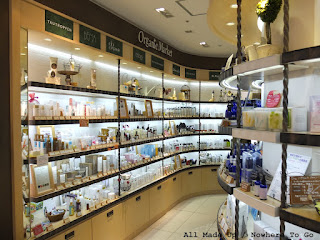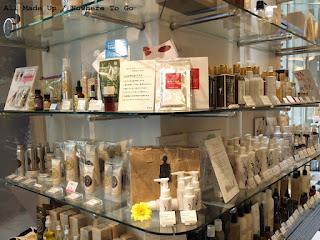One of my favourite things about Japan is the extreme specialisation and pride that people take in their work -- even the most seemingly menial tasks are executed diligently and beautifully. I went to a gyoza restaurant recently (one of the tiny one room mom and pop shop type places) and watched in awe as the old man behind the counter churned out hundreds of dumpling shells. He must have done it every day for years, and he did it with such perfection. There was no sense of the mundanity of a repetitive task, but rather someone performing their chosen craft. I have a real soft spot for this side of Japanese life. I quite often see restaurants and shops which only sell one thing and never seem to have any customers. They must be entirely financially unviable, but are clearly the product of a dearly held dream -- run for love not money.
I also love the regional specialisation (I believe this is called meibutsu). Some people dislike this as they see it as perpetuating the omiyage culture (obligatory gift-buying whenever you go on holiday which seems to function almost as repentance for letting your work colleagues down by your absence), but I love the sense of pride and quality that it encapsulates. Small-scale regional manufacturers turning out hand-crafted wares also means small production runs, limited availability and high price points, which I think helps engender the cult status of many Japanese-made goods. For example, Japanese denim, produced on small looms in Kojima, Okayama prefecture, is considered by many to be the best in the world (for more information see this SOAS research piece).
Similar cult status is afforded to Japanese make-up brushes. The town of Kumano, near Hiroshima, is famous for the production of hand-made brushes (not just make-up tools, also calligraphy and art brushes), known as Kumano Fude. There are around 30 different brush companies based in Kumano. The brushes are so prized because the highly-skilled craftsmen hand select the (usually uncut animal) hairs for each brush to produce perfectly weighted, beautiful quality brushes. Each stage of the process is typically performed by a specialised craftsman -- from hair selection to bundling the head, producing the handles, attaching the ferrule and so on. For more information on the history and manufacture process see the Kumano Fude website.
The best known Kumano companies are probably Hakuhodo and Chikuhodo. As well as producing their own-brand brushes, they also make them for a number of other companies. For example, Suqqu, RMK and Kanebo brushes are made by Chikuhodo and Hakuhodo produces brushes for Tom Ford (and formerly MAC).
This post isn't going to be a guide to Haku and Chiku brushes, but rather a quick outline of where you can find them in Tokyo. For those stuck on where to begin deciding what to buy, there are some excellent blog posts introducing the lines. I particularly recommend the following:
- Glossed in Translation's Hakuhodo series, which includes a very useful introductory post and buying guide;
- Diabolus in Cosmetica's introduction to Chikuhodo and Hakuhodo brushes;
- Sweet Make-up Temptations, which contains a huge amount of information -- I won't link a specific post as there are so many, but I definitely recommend visiting Sonia's blog if you're interested in brushes; and
- Drivel About Frivol for a number of really helpful comparison posts.
View Brush shopping in Tokyo in a larger map
 Hakuhodo brushes are fairly widely available across Tokyo. There are counters at a number of department stores, including Mitsukoshi Ginza and Tobu Ikebukuro (see my department store guides here and here). However, the counters only carry a small number of the huge range of Haku brushes so if you have time I highly recommend paying a visit to their Aoyama boutique in Omotesando. As with most places in Tokyo, it's quite difficult to find and it's almost essential to have a Google Maps app. A bonus is that once you do finally find it, the shop is just down the road from the excellent Kua 'Aina Hawaiian burger cafe.
Hakuhodo brushes are fairly widely available across Tokyo. There are counters at a number of department stores, including Mitsukoshi Ginza and Tobu Ikebukuro (see my department store guides here and here). However, the counters only carry a small number of the huge range of Haku brushes so if you have time I highly recommend paying a visit to their Aoyama boutique in Omotesando. As with most places in Tokyo, it's quite difficult to find and it's almost essential to have a Google Maps app. A bonus is that once you do finally find it, the shop is just down the road from the excellent Kua 'Aina Hawaiian burger cafe.
The Omotesando shop sells the full range of brushes, which is extensive -- as you can see from my dodgy iPhone pics below.

Until recently it wasn't possible to buy Chikuhodo brushes in Tokyo other than at the occasional temporary pop-up stand in major department stores.
 Fortunately last summer they opened a counter at the TAU Hiroshima brand shop in Ginza. The Kumano Fude shop on the 2nd floor sells a selection of brushes produced by Chikuhodo, Koyudo, Tanseido, Kyukasangyo, Nakamura and Mizuho Brush.
Fortunately last summer they opened a counter at the TAU Hiroshima brand shop in Ginza. The Kumano Fude shop on the 2nd floor sells a selection of brushes produced by Chikuhodo, Koyudo, Tanseido, Kyukasangyo, Nakamura and Mizuho Brush.
 Fortunately last summer they opened a counter at the TAU Hiroshima brand shop in Ginza. The Kumano Fude shop on the 2nd floor sells a selection of brushes produced by Chikuhodo, Koyudo, Tanseido, Kyukasangyo, Nakamura and Mizuho Brush.
Fortunately last summer they opened a counter at the TAU Hiroshima brand shop in Ginza. The Kumano Fude shop on the 2nd floor sells a selection of brushes produced by Chikuhodo, Koyudo, Tanseido, Kyukasangyo, Nakamura and Mizuho Brush.
This is a genuinely fascinating little shop. I find the staff unfailingly helpful. They also let me play with the Kiwami set so I obviously love them. The shop doesn't carry every single Chiku brush, but they do have a good selection and stock most of the Artist and Z series.
Note that Chikuhodo still have the travelling department store counters. Details of these are listed on their website under 'What's New' (non-Japanese speakers will need to use Google translate).
Note that Chikuhodo still have the travelling department store counters. Details of these are listed on their website under 'What's New' (non-Japanese speakers will need to use Google translate).
Hopefully I will at some point get around to writing a post on my favourite Haku and Chiku brushes. I am also keen to pay a trip to Kumano and visit the museum there...




























